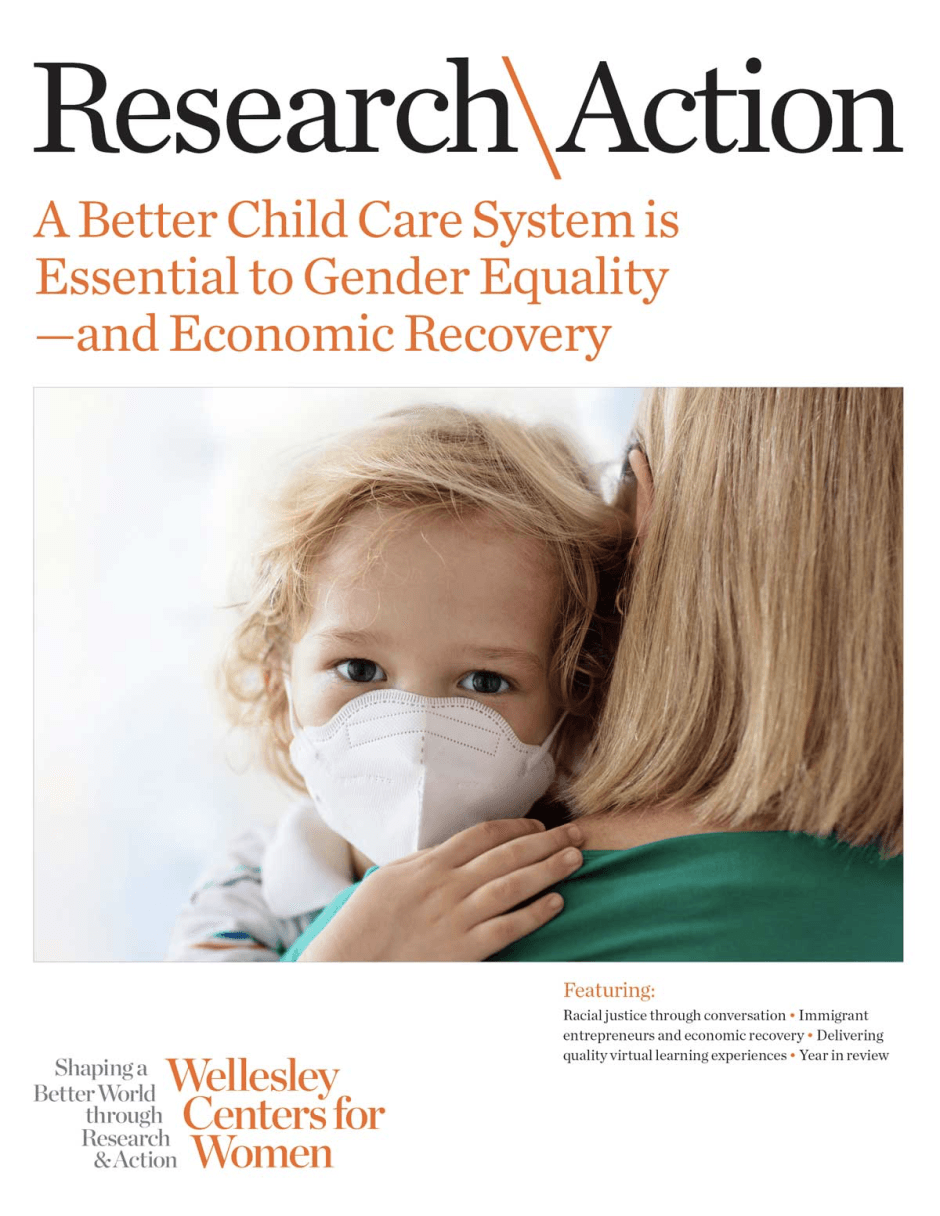Commentary by Wendy Wagner Robeson, Ed.D.
 We are in the midst of what has been called a “crisis of care.” Since the COVID-19 pandemic hit the U.S. earlier this year, working parents have struggled to find care for their children as schools and child care centers closed. This crisis of care has been a disaster for women’s participation in the workforce and, by extension, for gender equality and the economy as a whole.
We are in the midst of what has been called a “crisis of care.” Since the COVID-19 pandemic hit the U.S. earlier this year, working parents have struggled to find care for their children as schools and child care centers closed. This crisis of care has been a disaster for women’s participation in the workforce and, by extension, for gender equality and the economy as a whole.
When families can’t access child care for their young children, or when older children need supervision while they attend school remotely, women end up cutting back their hours or leaving their jobs altogether. The gender wage gap contributes to this: In families with two working parents, it makes economic sense for the lower-earning spouse to be the one to stop working. In heterosexual couples, that is often the mother.
Data released by the U.S. Department of Labor in October show that women are leaving the workforce in droves, wiping out the hard-won gains made in the last several decades. Of the 1.1 million people aged 20 and older who left the workforce between August and September, over 800,000 were women. That includes 324,000 Latina women and 58,000 Black women. Women of color have suffered the most, with unemployment rates for both Latina and Black women rising to 11%.
According to the U.S. Census, between April and July, more than one-third of working millennial moms said they were unable to work due to caring for children not in school or child care. And the Lean In organization recently reported that one in three mothers may be forced by the pandemic to scale back their hours or leave the workforce entirely.
When women drop out of the workforce, they have a difficult time re-entering it later, and a very difficult time finding jobs that pay as much as they were previously earning — reducing their lifetime earnings potential. This widens the gender pay gap and perpetuates the conditions that drive women to leave the workforce, creating a vicious cycle that results in more inequality.
Even when mothers are able to continue working, they are doing an impossible juggling act of work, child care, and housework — taking on a larger share of the child care and housework burden than fathers — that has detrimental effects on their careers and their mental health. A recent study by Qualtrics and theBoardlist found that twice as many women as men believed that working from home could have a somewhat or extremely negative impact on their careers, and that fathers were three times as likely as mothers to receive a promotion while working from home.
Over the summer, a colleague and I conducted focus groups with several dozen parents who have kids under the age of 5, sponsored by the Boston Mayor’s Office of Women’s Advancement. The parents told us how exhausting it was to always be either working or parenting, with no time left for themselves. Mothers in particular felt that they could not be both good moms and good employees; their inability to meet their own expectations was causing a lot of mental anguish. It’s no wonder that many are deciding this situation is unsustainable, and cutting back hours or dropping out of the workforce.
Economic recovery depends on parents being able to work, and therefore on a reliable system of child care. We’ve long known about the lack of affordable, accessible, and high-quality care for young children in the U.S., and now this problem has reached a breaking point. Child Care Aware estimates that 30-50% of child care programs will close permanently. These programs got by on razor-thin margins before the pandemic, and after being closed for months during lockdowns, and reopening with limited capacity and extra expenses due to new health regulations, many simply cannot afford to keep their doors open. This will make it harder for parents to find the child care they need in order to return to work.
We should take this opportunity to not just help early childhood care and education programs get through this current crisis — though that is critical — but to rethink our whole system and build one that works better for everyone. While middle-class households spend on average 10% of their budget on child care, low-income households spend a third of their budget. This is a situation that cannot continue.
Since the pandemic began, I’ve been participating in daily calls with other early childhood care and education advocates in Massachusetts, led by the nonprofit organization Strategies for Children. We’ve been in communication with state and federal leaders about what kind of support child care programs and their staff need going forward. A major investment, particularly at the federal level, is necessary. This would allow for an expansion of affordable child care, improvement in the quality of that care, and higher wages for its woefully underpaid workforce.
My colleague Nancy Marshall, Ed.D., and I have spent 30 years studying early childhood care and education in the U.S. through WCW’s Work, Families & Children Research Group. Our research has shown that a robust national child care policy is the only long-term solution that will meet the needs of children and families.
A national policy would have to address the issue of affordability, with free universal pre-kindergarten for all preschool-age children, subsidies on a sliding scale for families with infants, toddlers and school-age children, and guaranteed paid parental leave.
It would also need to ensure access to quality care, with national standards for group size, ratios of children to staff, health and safety, and workforce qualifications. It would align higher education with the core competencies for child care professionals, and provide ongoing professional development, including coaching.
Last but certainly not least, it would have to address challenges faced by the early childhood care and education workforce, with the goal of raising wages, maintaining diversity, and reducing turnover. This workforce needs wages worthy of the essential role they play, with pay comparable to that of public school teachers. They also need a career lattice rather than a single path, with multiple points of entry into careers in early childhood care and education, and various ways to advance in the field.
These are changes that would benefit both women and men. (As we say at WCW, a world that is good for women is good for everyone.) Child care is not a women’s issue; it is a public good that is inseparable from the economy as a whole. We cannot achieve gender equality or economic recovery until our child care system is rebuilt from the ground up. Let’s take this opportunity to do it sooner rather than later.
Wendy Wagner Robeson, Ed.D., is a senior research scientist with the Work, Families & Children Research Group at WCW and lecturer in Wellesley College’s Department of Women’s and Gender Studies. She has an extensive research background in child development, early childhood care and education, child care policy, school readiness, literacy, and language. Since the beginning of the pandemic, Robeson has worked with early childhood education advocates across Massachusetts to assess the impact of COVID-19 on the child care and education industry.


